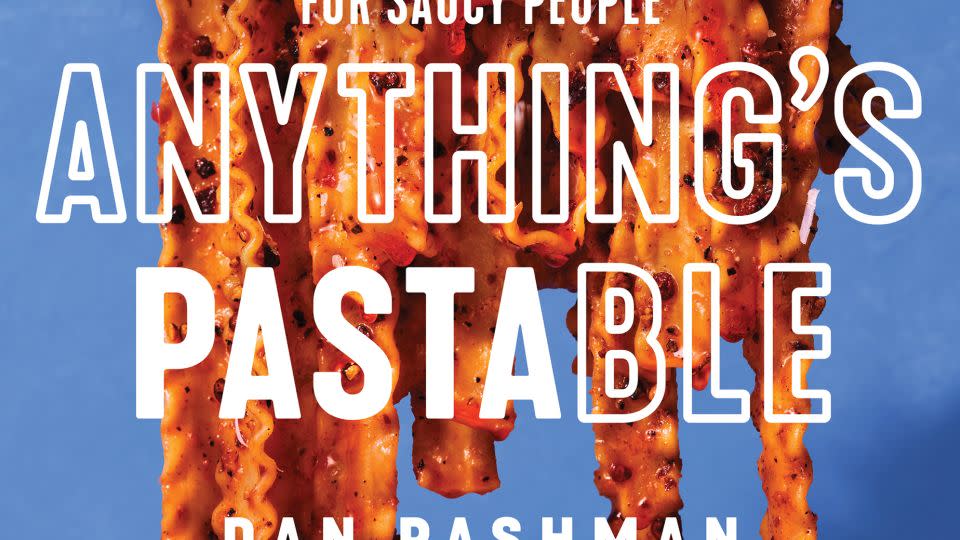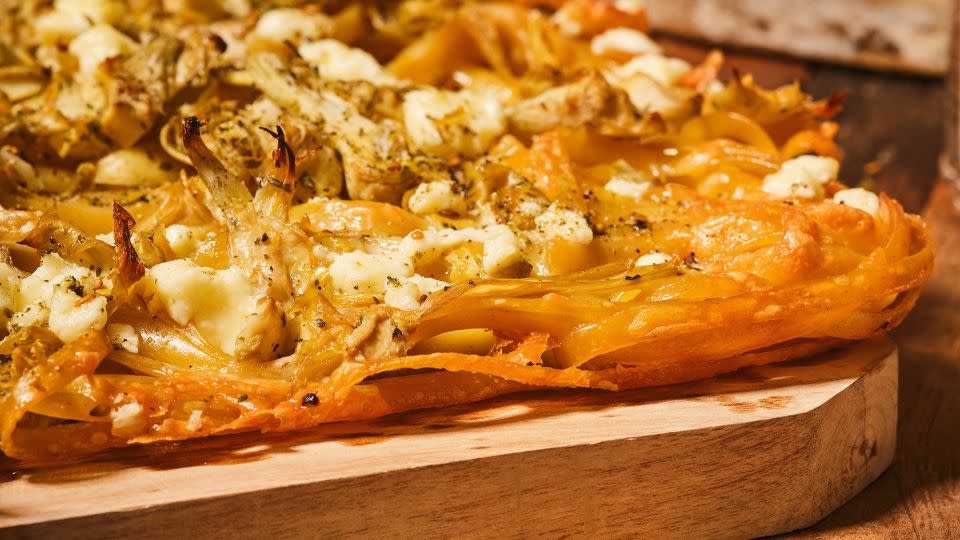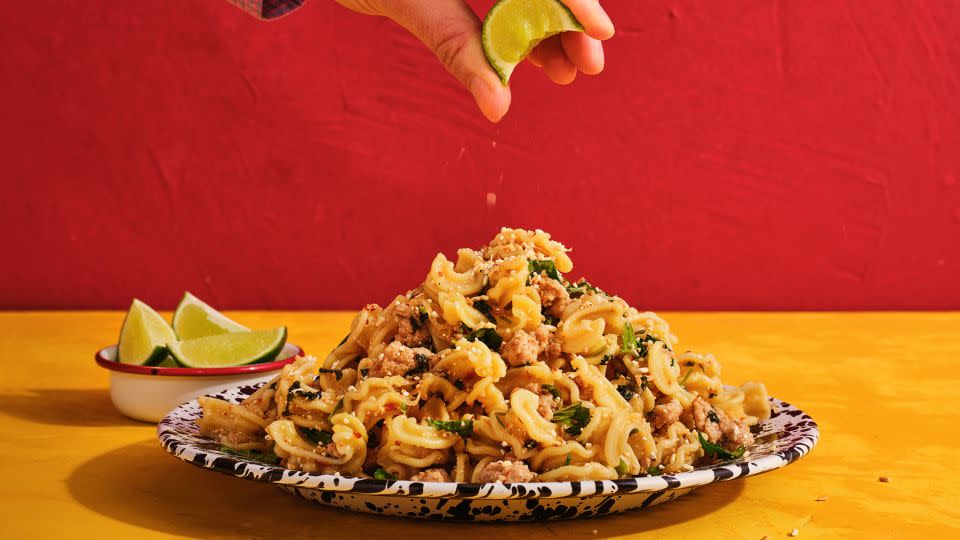4 ingredients to level up your pasta recipes
Sign up for CNN’s Eat, But Better: Mediterranean Style. Our eight-part guide shows you a delicious expert-backed eating lifestyle that will boost your health for life.
Horrified by pasta shapes that do not hold onto sauce, Dan Pashman spent three years designing and testing a new pasta shape.
Unlike spaghetti, which most sauces slide right off, or tubes that do a surprisingly poor job of holding sauces inside, according to Pashman, this noodle was engineered to maximize the factors he thinks are most important in noodles: forkability, sauceability and toothsinkability.
The result: A short, curved pasta features two parallel ruffles on one side, with a small sauce-holding well between them. The first batch of 3,700 boxes of cascatelli (Italian for “waterfall”) online sold out in less than two hours. It turns out, listeners of Pashman’s podcast, “The Sporkful,” weren’t the only ones smitten with this new noodle. One publication named it one of the top 100 inventions of the year in 2021.
As cascatelli manufacturer Sfoglini’s supply caught up with demand, more home cooks were able to get their hands on a box and start putting it to good use. Pashman soon witnessed the sad state of sauces fans used when they tagged him on Instagram.
While he was glad people were enjoying his noodles, he thought the toppings lacked creativity: tomato sauce, meat sauce, mac and cheese, pesto; lather, rinse, repeat.
Rather than simply stew about the standard sauces, Pashman gathered his own dream team of recipe developers and culinary experts to develop a cookbook. Their mission: Convince home cooks to try a wide world of options to put on their noodles, cascatelli or otherwise.
The journey started with a trip to Italy during which Pashman had a game-changing discovery. “I learned that pasta has only been the national food of Italy for about the past 100 years,” he said. “Many iconic pasta dishes like carbonara, which I would have guessed the Roman emperors were eating, were only invented since the 1940s.”
At that point, he felt much less pressure to color inside the lines of the Italian culinary canon.

Like many forms of food culture, he saw that pasta continues to change and evolve. New dishes are created in Italy and around the world every day, and his March 2024 cookbook is designed to color outside the lines.
With “Anything’s Pastable: 81 Inventive Pasta Recipes for Saucy People,” “I hope that people realize that there’s so much more than they can and should be putting on pasta,” Pashman said. “It’s like a blank canvas and can be a beautiful base for almost any form of deliciousness that you can imagine.”
Some of the recipes, including Shakshuka and Shells, Kimchi Carbonara and Spaghettoni Alla Tadka, feature ingredients that some home cooks might consider more global than you would find in the pasta chapter of a typical cookbook. That’s by design, Pashman said.
“I hope that this book will further normalize some of the ingredients and cuisines that I’m taking inspiration from,” he said. “This approach to pasta is just a natural extension of how our country has gotten more diverse in recent decades, and a broader range of food cultures are assimilating into the mainstream. These are global recipes, but they’re also American.”
4 ways to elevate your pasta
While Pashman offered four ways to get creative with your pasta, you can do so easily and affordably in your kitchen if you have any of a few interesting pantry staples on hand.
Chili crisp
Made with oil, chili peppers and a flavoring element such as soy sauce, fried garlic or fried shallots, this condiment delivers an explosion of flavor and texture in every spoonful.
“There are several recipes that call for chili crisp, like Cacio e Pepe Chili Crisp, and there’s almost nothing you can’t put this on,” Pashman said. He’s particularly fond of pairing it with dairy; in his riff on cacio e pepe, it teams up with cheese, and for dessert, try it on ice cream.
Lao Gan Ma is one of the crunchiest and iconic chili crisps, Pashman said. If you like it hot, seek out Fly by Jing. For a bit tamer heat but loads of crunch, consider KariKari or S&B Chili Oil with Crunchy Garlic.
Za’atar
This Middle Eastern seasoning mix is incredible on roast chicken, focaccia or fried eggs, and it also comes in handy in several of his cookbook’s recipes, Pashman reveals. Spice-blend recipes vary, but za’atar most commonly features ground sumac, thyme (the word za’atar is Arabic for thyme), sesame seeds, occasionally also including marjoram, oregano, cumin or coriander.
“It’s in our Shakshuka and Shells and one of the pasta pizzas, which is a pizza with a crust that’s made of pasta instead of dough,” Pashman said. “The toppings are inspired by what we add to one of our go-to regular homemade pizzas in our house: artichoke, feta and za’atar.”

Preserved lemons
Lemon, lime and the zest from both are featured throughout the book, and there is also plenty of preserved lemon, which Pashman deems a “punchy powerhouse.”
“I love lemons so much that I have lemon wallpaper in my kitchen,” Pashman added.
Common in North African cuisine, salted, spiced lemons are funky, tart, savory, salty and, of course, citrusy, Pashman said. He uses them in place of regular lemons in recipes such as Crispy Gnocchi Salad with Preserved Lemon-Tomato Dressing and Cavatelli with Roasted Artichokes and Preserved Lemon.
Whole preserved lemons (yes, you can eat both the flesh and the rind) are sold in jars at many supermarkets and specialty stores. You’ll want plenty, as preserved lemons are also incredible in salad dressings, marinades, tagines and yogurt sauces.
Ritz Crackers
Many Italian and Asian noodle and rice dishes incorporate texture, Pashman said. However, “most of the pasta dishes in America just did not get that memo. They’re very mono-textural,” he said. “Once you start incorporating different textures into your pasta, it starts to get hard to go back to the same ol’, same ol’.”
To lend satisfying crunch to any pasta recipe, Pashman has a section all about pangrattatos. Traditionally, these are toasted breadcrumbs and seasonings, but for a buttery, crunchy twist, Pashman recommends trying a topping with crumbled Ritz Crackers.
Try Ritz Crackers and Chive Pangrattato atop Cauliflower and Beer Cheese Mac, or on any salad with ranch or Caesar dressing. (Skip the croutons.) All you need to make it? A sleeve of crumbed Ritz Crackers, a little unsalted butter and a handful of minced fresh chives.

Dan Pashman’s Larb-ish Cascatelli Pasta
Makes 4 to 6 servings | Total time: 45 minutes
This recipe uses hot oil to bloom the fragrant Thai chili flakes, then adds plenty of lime juice, fish sauce and toasted rice powder to bring together the signature flavors of the spicy Thai dish called larb, according to Pashman. Cascatelli is a perfect pairing as it holds on to the bits of meat, he said.
Thai chili flakes are available online and at many Asian markets and some supermarkets. Larb is supposed to be hot, but unless you prefer food that’s extremely spicy, stick with 1 tablespoon chili flakes, Pashman advised.
For a shortcut, you can buy the toasted rice powder instead of making it. Substitute 3 tablespoons prepackaged toasted rice powder for the 1 teaspoon oil and ¼ cup rice and skip step 1. Toasted rice powder is available online or in Asian grocery stores, where it may be called khao khua (Thai) or bột thính gạo or thinh (Vietnamese).
Ingredients
● 1 teaspoon plus ¼ cup canola or other neutral oil
● ¼ cup uncooked glutinous or jasmine rice
● 2 tablespoons kosher salt
● 3 medium shallots, sliced into very thin rings
● ½ cup roughly chopped fresh cilantro leaves and tender stems, divided
● ½ cup roughly chopped fresh mint leaves, divided
● 2 scallions, sliced
● 1 to 3 tablespoons Thai chili flakes
● 2 tablespoons brown sugar
● ¼ cup fish sauce
● ¼ cup freshly squeezed lime juice, plus lime wedges for serving
● 1 pound ground pork, turkey or chicken
● 1 pound cascatelli pasta (or radiatore or creste di gallo)
Instructions
1. Make the toasted rice powder: Heat 1 teaspoon oil in a large skillet over medium heat. Add the rice and toast the grains, stirring and shaking the pan often, until deep golden brown, 4 to 6 minutes. Transfer to a spice grinder, reserving the skillet, and pulse until powdery. (The rice can also be pounded in a mortar and pestle, but it will take some time and elbow grease to achieve the right texture; it can be a little uneven, but you don’t want large pieces or whole grains of rice.)
2. Bring 4 quarts of water and the salt to a boil in a large pot.
3. In a large heatproof bowl, combine the shallots, ¼ cup cilantro, ¼ cup mint, scallions, chili flakes and sugar. Heat the remaining ¼ cup oil in the reserved skillet over high heat until just starting to smoke. (This may take several minutes depending on your stovetop; you want the oil extremely hot.) Carefully pour the hot oil over the shallot-herb mixture (it should sizzle), reserving the skillet. Add the fish sauce and lime juice to the bowl and stir until the sugar is dissolved.
4. Add the meat and ¼ cup water to the reserved skillet and cook over medium-high heat, stirring occasionally and breaking up the meat, until cooked through but not browned, 6 to 8 minutes. (If the meat begins to color, add more water to the skillet 2 tablespoons at a time to prevent browning.) Use a slotted spoon to transfer the meat to the bowl with the shallot-herb mixture, discarding any liquid in the pan. Add the remaining ¼ cup each of cilantro and mint and stir to combine. (If making ahead, wait to add the remainder of the cilantro and mint until you start cooking the pasta; cover the meat mixture and set aside for up to 1 hour before proceeding with the recipe.)
5. Add the pasta to the boiling water and cook until just al dente (the low end of the package instructions). Drain, shaking off the excess water, and return to the pot. Add the meat mixture to the pasta, scraping out the bowl, along with three-quarters of the rice powder. Toss to combine.
6. Transfer to a serving dish or individual bowls, sprinkle with the remaining rice powder and serve with lime wedges.
Karla Walsh is a Des Moines, Iowa-based freelance lifestyle writer with more than 15 years of editorial experience.
Recipe adapted from “Anything’s Pastable: 81 Inventive Pasta Recipes for Saucy People” by Dan Pashman. Copyright © 2024 by Sporkful, LLC. Published by William Morrow, an imprint of HarperCollins Publishers
For more CNN news and newsletters create an account at CNN.com

